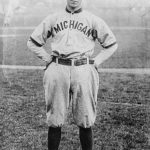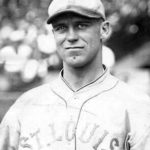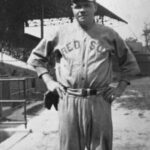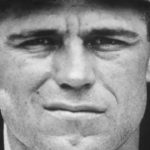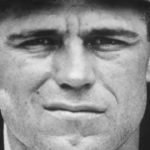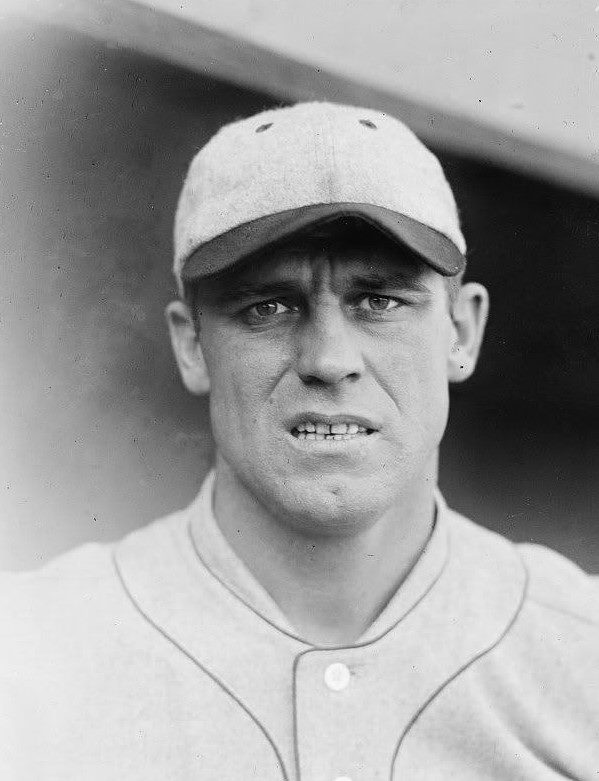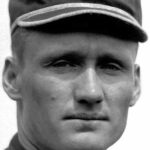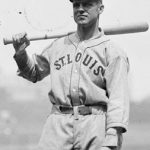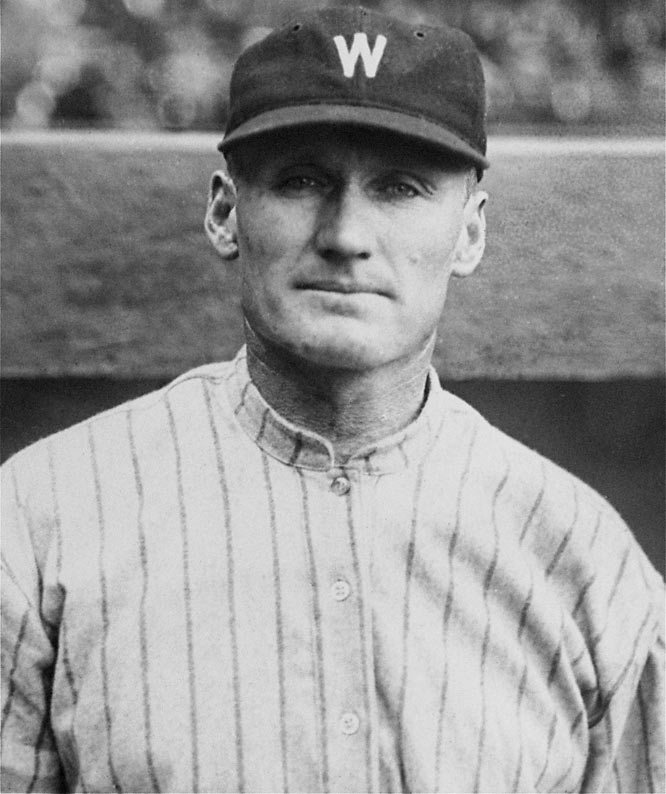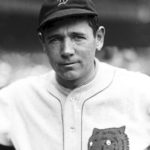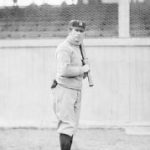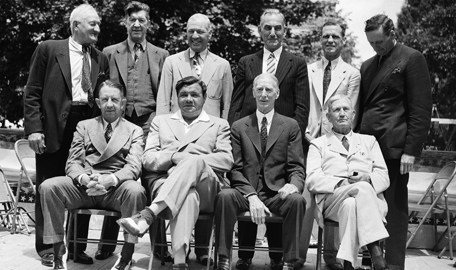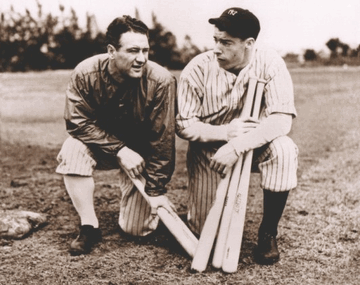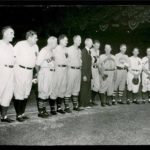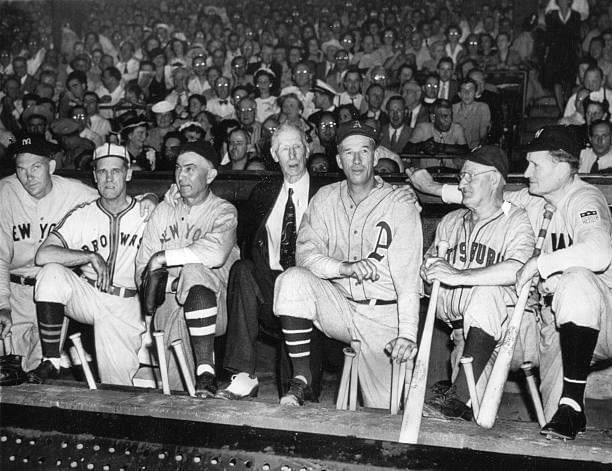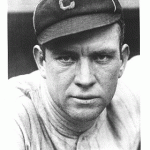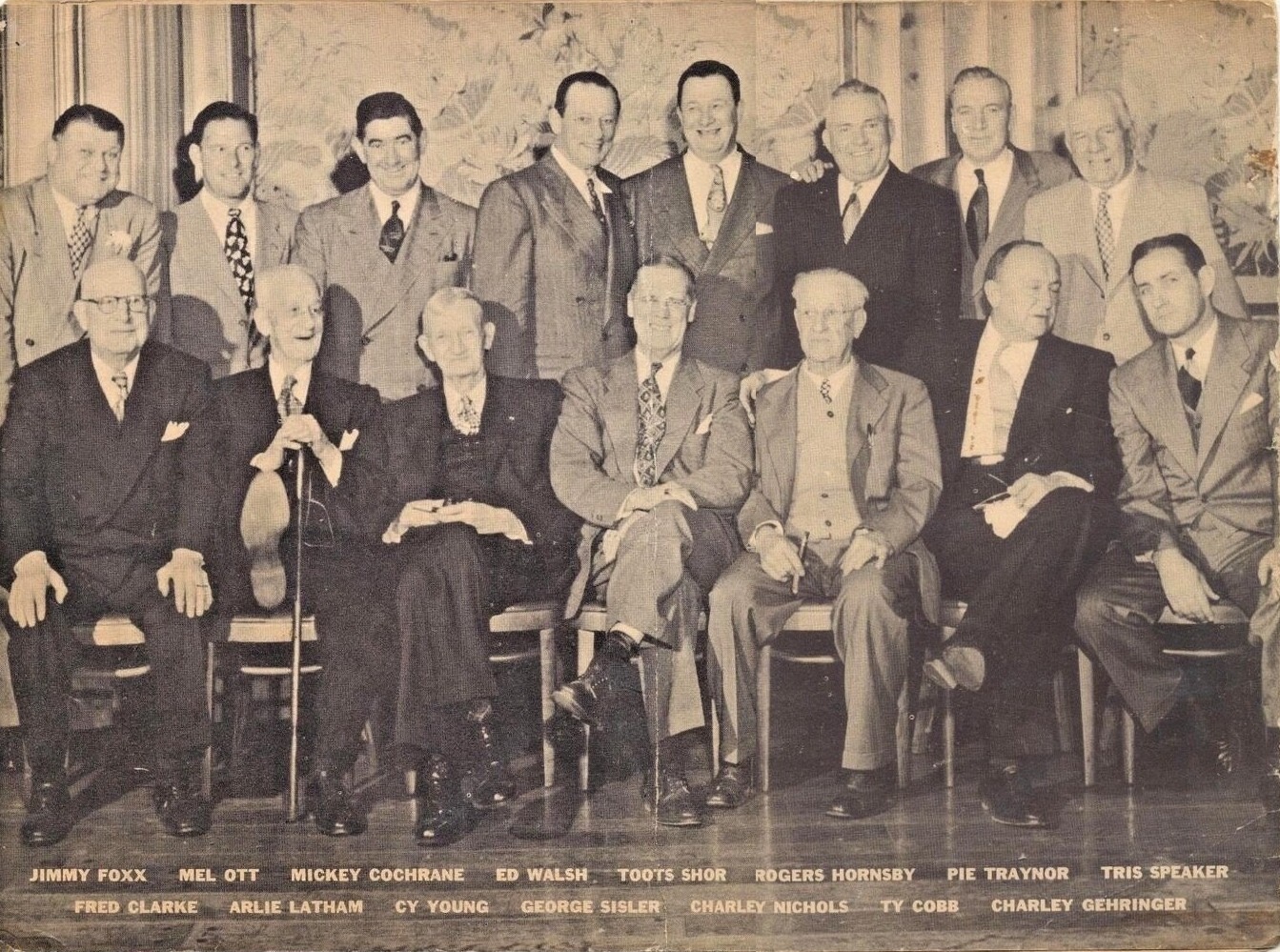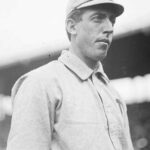George Sisler Stats & Facts
George Sisler
Position: First Baseman
Bats: Left • Throws: Left
5-11, 170lb (180cm, 77kg)
Born: March 24, 1893, in Manchester, OH
Died: March 26, 1973 in Richmond Heights, MO
Buried: Old Meeting House Presbyterian Church Cemetery, Frontenac, MO
High School: Akron HS (Akron, OH)
School: University of Michigan (Ann Arbor, MI)
Debut: June 28, 1915 (4,338th in MLB history)
vs. CHW 3.0 IP, 2 H, 2 SO, 1 BB, 0 ER
Last Game: September 22, 1930
vs. CHC 1 AB, 0 H, 0 HR, 0 RBI, 0 SB
Teams George Sisler Played For
St. Louis Browns (1915-1927)
Washington Senators (1928)
Boston Braves (1928-1930
Awards and Honors
1922 AL MVP
Hall of Fame: Inducted as Player in 1939. (Voted by BBWAA on 235/274 ballots)
View George Sisler’s Page at the Baseball Hall of Fame (plaque, photos, videos).
Nicknames: Gorgeous George
View Player Bio from the SABR BioProject
Relatives: Father of Dave Sisler, Dick Sisler
George Sisler’s Baseball Reference Page
Nine Players Who Debuted in 1915
Sam Rice
Rogers Hornsby
Joe Judge
George Sisler
Dave Bancroft
Dazzy Vance
Charlie Jamieson
George Kelly
Baby Doll Jacobson
All-Time Teammate Team
Notable Events and Chronology for George Sisler Career
George Sisler never played on a pennant winner and he wasn’t a slugger, but in spite of that, he earned a reputation as the best first baseman in the first 30 years of the 20th century. The greatest player in St. Louis Browns’ history, he twice batted over .400, and his 257 hits in 1920 remain a modern major league record. That same year, the lefty-swinging Sisler hit in 41 consecutive games, an American League record that stood until surpassed by Joe DiMaggio. Sisler, who attended the University of Michigan, where he played for Branch Rickey, was elected to the Hall of Fame in 1939.
Biography
George Harold Sisler was born on March 24, 1893, in the tiny community of Nimisila Creek, Ohio, just south of Akron. Though many sources claim Sisler was born in Manchester, Ohio, evidence shows that he was not actually born in Manchester, which is a stone’s throw from Nimisila. Sisler’s parents were educated, each having attended Hiram College, located northeast of Akron. Sisler’s family was fairly prominent in that region of Ohio: his uncle was a successful politician, and his father, Cassius S. Sisler, was the supervisor of the largest coal mine in the area.
As a young child, Georgie Sisler exhibited great speed and agility in athletics, so much so that at the age of 14, he transferred to Akron High School in 1907 so he could play baseball. A strong left-handed thrower, Georgie pitched for Akron High and distinguished himself to the degree that he signed a professional contract with the Akron Champs of the short-lived Ohio-Pennsylvania League (1905-1912). But upon his high school graduation, Cassius Sisler urged his son to enroll at the University of Michigan, who had offered a scholarship to play baseball.
With Michigan, Sisler played under Branch Rickey, who was also employed as a scout for the St. Louis Browns at the time. While Sisler was starring for the Wolverines, his rights were retained by Akron, who subsequently transferred them to their parent club, Columbus. Eventually, Sisler’s rights were sold to Pittsburgh of the National League, and in 1913 and 1914, the Pirates listed Sisler on their official roster sheets. Meanwhile, in Ann Arbor, Sisler established himself as the finest collegiate player in the nation, starring both on the mound and at the plate. In his senior season, he hit nearly .500 and won 11 games for the Wolverines. Rickey, salivating at the chance to sign Sisler to a major league contract with the Browns, worked with George to void his contract status with Pittsburgh, claiming that the original deal with Akron had been entered into while Sisler was still a minor.
The entire mess became one of the biggest sports headlines in the nation in late 1914 and early 1915. Finally, on January 9, 1915, the National Commission declared that Sisler was a free agent, eligible to sign with any club. Pittsburgh owner Barney Dreyfuss, furious over the decision, barely spoke to Garry Herrmann, owner of the Cincinnati Reds and a member of the commission, ever again. After graduating, Sisler signed with the Browns (now managed by Rickey), for a reported $5,000 bonus and $400 per month.
With the Browns in 1915, the 22-year old college graduate stuck out like a sore thumb on a team that featured mostly southerners and high school graduates, with few educated men. But the presence of Rickey made the transition to professional baseball smooth for Sisler, who was a shy, sensitive young man. Originally used as a pitcher, Sisler appeared in 15 games on the mound, posting a 2.83 ERA, while fanning 41 batters in 71 innings. On days he wasn’t pitching, Sisler played first base or the outfield, hitting a respectable .285 with 15 extra-base hits. The following year, saddled with a dismal offensive team, new manager Fielder Jones inserted Sisler as his everyday first baseman, using him on the mound in just three games. Sisler acclimated well to the switch, showing flashes of the stellar defensive play that would mark his career. At the plate, the left-handed hitter batted .305 to lead the team, which posted a winning record for the first time since 1908.
A relatively average-sized man, Sisler utilized a great batting eye and quick feet to get on base, batting anywhere from leadoff to third in the order. In 1917 he batted .353 to finish second to Ty Cobb in the American League batting race. His 190 hits also ranked second in the loop. The following season, Sisler batted .341 in a season shortened due to The Great War in Europe. He was back in 1919, setting career-high marks in doubles, triples, and homers while batting .352, which ranked third behind Cobb and Bobby Veach, both of Detroit. In 1920, Sisler exploded for one of the greatest offensive campaigns in baseball annals. He hit .407 to earn his first batting title while playing every game and every inning of the season. He paced the league in assists at first base and was generally regarded as the best defensive first baseman in the game, and the heir apparent to Hal Chase for that honor. At the plate, Sisler laced an astonishing 257 hits, or roughly three every two games. The total was a major league record that still stood entering the 2004 season. Among his 257 safeties were 49 doubles, 18 triples, and 19 home runs, which meant Sisler ranked second to Babe Ruth for the second straight season in that category. Though he never swung for the fences, Sisler did rank in the top ten in homers five times. During the 1920 season, Sisler, who rarely went more than one game without a hit, enjoyed a 25-game hitting streak.
In his first six seasons with the Browns, Sisler was surrounded with little talent, as the club finished no higher than fourth in the American League. Fielder Jones was replaced by Jimmy Austin and then Jimmy Burke, in 1918, and in 1921 Lee Fohl took the managerial reigns. Fohl’s team was far more talented than previous Browns clubs, however, bolstered by Sisler’s torrid hitting. In 1921, Sisler, dubbed “Gorgeous George” for his flashy fielding plays, banged out 216 hits, batted .371, and drove in 104 runs. That season, the Browns’ talented outfield trio of Baby Doll Jacobson, Jack Tobin, and Ken Williams also had fine seasons, and pitching ace Urban Shocker won 27 games. In 1922, the group led the Browns to the top of the standings for much of the season, as Sisler had his finest year. Narrowly missing his own-hit mark, Sisler collected 246 hits, but more impressively, he hit .420 to cop his second batting crown. He came on late, hitting over .440 for the last two months of the season and putting together a league-record 41-game hitting streak, as St. Louis and the Yankees battled for the pennant. Ultimately, the Browns finished one game behind New York in the best showing of Sisler’s years with the franchise. Sisler collected 42 doubles, 18 triples, eight homers, 105 RBI, and led the league with 49 stolen bases.
In 1923, Sisler sat out the entire season after he contracted poisonous sinusitis, an affliction that affected his eyesight as well, and gave him terrible headaches. Without Sisler, the Browns won 19 fewer games in 1923, finishing a distant fifth. In 1924, the veteran Sisler was back, having inked a deal to play and manage the team. The managerial responsibility and the lingering effects of sinusitis limited George to a .305 average in 151 games. The club finished with an identical record as it had posted the previous season. He managed the team for two more years, guiding the Browns to a third-place finish in 1925, and 92 losses in 1926, before resigning to turn the job over to Dan Howley. In 1925, Sisler regained some of his batting lusters, hitting .345 with 224 hits, but in ’26, he hit a disappointing .290 in 150 games.
Hoping to regain his batting championship form, Sisler attacked the 1927 season unfettered by managerial responsibility. After a strong start, he tapered off, but still managed 201 hits, a .327 average, and 97 runs batted in. Even though he was 34 years old and his legs were beaten from years of punishment, Sisler’s 7 stolen bases led the league. After Heinie Manush and Lu Blue (a switch-hitting first baseman) were acquired in a blockbuster deal in early December, Sisler was sold to the Washington Senators in a move extremely unpopular with St. Louis fans. He played just over a month with Washington, where he hit .245, before he was shipped to the Boston Braves, baseball’s equivalent of Siberia. In his first look at National League pitching, Sisler hit a robust .340 with 167 hits in 118 games. That earned him two more seasons in the Hub City, where he hit .326 in 1929, and .309 in 1930. Though he had rebounded to have some solid seasons, Sisler felt he never fully recovered from the sinusitis that sidelined him for the entire 1923 schedule.
In 1931, nearing his 38th birthday and receiving no offers from big-league clubs, Sisler signed with Rochester of the International League. In 159 games for Rochester, Sisler batted .303. The following year, he took an assignment as manager of Shreveport/Tyler of the Texas League, finding time to play in 70 games and hit .287 with 17 steals at the age of 39. Sisler then retired as a manager and player. Sisler posted a .340 lifetime batting mark in the big leagues, led the league in assists six times as a first baseman, and in putouts several times as well. He collected 2,812 hits, 425 doubles, 164 triples, 102 homers, 1,175 RBI, and 375 stolen bases. He had struck out only 327 times in his 15-year career. His abbreviated pitching mark stood at 5-6 with a 2.35 ERA in 111 innings. In 1939, he was elected to the new Hall of Fame in Cooperstown, New York. He was one of the living members who attended that first induction ceremony.
A few years later, in 1946, his second-oldest son, Dick, made his big league debut with the St. Louis Cardinals. Dick Sisler, who at six-foot, two-inches, was much larger than his famous father, played eight seasons in the majors. His shining moment came on October 1, 1950, at Ebbets Field in Brooklyn, when his 10th inning home run gave the Phillies the NL pennant. George’s youngest son, Dave, pitched for seven years for four major league teams from 1956-1962, winning 38 games. George Jr., the oldest son, had enjoyed a brief minor league stint before embarking on a successful career as president of the International League.
Starting in 1943, and through 1950, Sisler was reunited with Branch Rickey, serving as a scout for the Dodgers, for whom Rickey was club president. When his old college coach moved to the Pirates in 1951, George followed along, and Sisler stayed on the Pittsburgh payroll as an instructor and scout until his death in a St. Louis suburb in 1973, two days after his 80th birthday.
Feats
Had a 41-game hitting streak in 1922, the longest in American League history until Joe DiMaggio broke it in 1941… In 1921, Sisler collected hits in ten straight plate appearances.
Milestones
Had he not missed the entire 1923 season with sinus problems, Sisler would have easily topped the 3,000 hit mark. As it was, he finished less than 200 hits away.
Notes
Sisler was the prototypical player for a hitting streak, combining great speed with a consistent line drive bat. During the 41-game streak, he had 23 multiple hit games, a record for a streak of any length. From September 4-11 he strung together seven straight multi-hit games, banging out 18 hits during that stretch. He hit .420 for the streak season, and batted .460 (80-for-174) during the streak, with 43 runs, 14 doubles, seven triples, no homers, 11 walks, five strikeouts, and 13 stolen bases… In 1925, the left-hander strung together 34 straight games with a hit, beginning on Opening Day. During that streak, he hit .399 (59-for-148), with 25 runs scored, three doubles, one triple, two homers, three walks, four strikeouts, and two stolen bases. Sisler racked up 224 hits in 1925…. Named 1922 American League Most Valuable Player; Elected to the Hall of Fame 1939… George Sisler was the favorite ballplayer of comedienne/actor W.C. Fields.
Hitting Streaks
41 games (1922)
34 games (1925)
25 games (1920)
Transactions
December 14, 1927: Purchased by the Washington Senators from the St. Louis Browns; May 27, 1928: Purchased by the Boston Braves from the Washington Senators.
Replaced
Jack Leary, the Browns’ first sacker in 1914 and part of 1915.
Replaced By
Sisler collected 201 hits and batted .327 in 1927 for St. Louis. He was 34 years old and had just stolen 27 bases and played his usual brilliant first base. The Browns were an aging team and had finished in seventh place. On December 2, they traded for Heinie Manush, the hard-hitting outfielder from Detroit. In the deal, St. Louis also acquired Lu Blue, a first baseman. Blue was a switch-hitter, who had benefitted from Ty Cobb’s tutelage and hit .300 or higher four times in Motown. But he was 30 years old, coming off an injury, and had hit a disappointing .260 for Detroit in 1927. For some reason, 12 days after the Manush deal, the Browns sold Sisler to Washington. Blue played three seasons as the Brown first baseman, never hitting higher than .293, though his power numbers were an improvement over Sisler, though slightly. Sisler played three more years, hitting .323, and in 1929, he collected 205 hits for the Bravesth 40 doubles and eight triples. By the end of the 1930 season, Sisler was 37 years old, but he hit .309 despite his eye troubles. He retired in January, and the Braves replaced him with 38-year old first baseman Earl Sheely.
Best Season: 1922
Sisler was a hitting machine. He led the AL in hits with 246, in runs with 134, and in batting with a .420 average. He enjoyed a 41-game hitting streak which lasted until the middle of September and was stopped only after he severely hurt his right arm. He had 42 doubles, 18 triples (league-high), 105 RBI, and a league-leading 51 stolen bases. It remains one of the best all-around offensive seasons in history. His 1920 season wasn’t too shabby, either. That year he played every inning of 154 games and hit .407 with a record 257 hits. Among his 399 total bases were 171 singles, 49 doubles, 18 triples, and 19 home runs. He went hitless in only 23 games and finished the campaign red-hot: batting .442 in August and .448 in September. Batting third in the St. Louis lineup, he drove in 122 runs, his career-high. He was his usual pesky self on the basepaths: swiping 46 bases in 65 tries.
Factoids
On September 1, 1918, Sisler hit a double off Ty Cobb. Cobb was making his first major league appearance on the mound. Sisler also pitched in the game for St. Louis.
As a pitcher, George Sisler defeated Walter Johnson twice. On July 25, 1918, he collected the only hit off Johnson, when the right-hander went the first 11 innings of a 15-inning game allowing just one hit.
Hall of Fame first baseman George Sisler was an effective left-handed pitcher early in his career. He hurled 111 innings over seven seasons, posting a 2.35 ERA.
Best Strength as a Player
Speed, and hitting for average.
Largest Weakness as a Player
He didn’t walk a lot, but seeing how he averaged about 220 hits a season, that isn’t much of a weakness. He was a lot like Ichiro as a hitter.
Bittersweet Defeat
In 1950, Sisler was the Head of Scouting for the Brooklyn Dodgers. The Dodgers and Phillies played each other in the final game of the season, with the pennant hanging in the balance. Sisler’s son Dick played for Philadelphia.
“Who are you rooting for?” George was asked. “I’ve forgotten how to root,” was his reply. Later of course, it was Dick Sisler’s three-run homer that was the difference in the game for the Phils as George’s Dodgers were defeated.
Despite his employer’s loss, George called the game his biggest thrill as a father.
Yer Out! Yer Out! Yer Out!
On April 9, 1922, in the finale of the “City Series” between the St. Louis Browns and St. Louis Cardinals, Sisler was thrown out at home plate three times by Cardinals’ outfielder Austin McHenry.
Where He Played
First base (1,971 games) and a little outfield (37). He also pitched early in his career, of course.
Nicknames
Gorgeous George, Sizzler, Gentleman George
Family Tree
George Sisler had three sons who played baseball: George Jr., Dick and Dave. The two youngest became major leaguers. George Jr. played in the minor leagues and later enjoyed a successful career as a minor league executive and team owner.
Similar Players
If Gold Glover Keith Hernandez could hit like George Brett and run the bases like Kenny Lofton, that would be George Sisler… Offensively and on the basepaths, Ichiro Suzuki is very similar.
Related Players
Sons Dave and Dick Sisler, Ichiro Suzuki
@ET-DC@eyJkeW5hbWljIjp0cnVlLCJjb250ZW50IjoicG9zdF90YWdzIiwic2V0dGluZ3MiOnsiYmVmb3JlIjoiTGVhcm4gTW9yZSBhYm91dCB0aGUgdGVhbXMsIHBsYXllcnMsIGJhbGwgcGFya3MgYW5kIGV2ZW50cyB0aGF0IGhhcHBlbmVkIG9uIHRoaXMgZGF0ZSBpbiBoaXN0b3J5IC0gLSAtIC0gLSAtIC0gIiwiYWZ0ZXIiOiIiLCJsaW5rX3RvX3Rlcm1fcGFnZSI6Im9uIiwic2VwYXJhdG9yIjoiIHwgIiwiY2F0ZWdvcnlfdHlwZSI6InBvc3RfdGFnIn19@
Factoids, Quotes, Milestones and Odd Facts
Coming soon
Other Resources & Links
Coming Soon
If you would like to add a link or add information for player pages, please contact us here.




